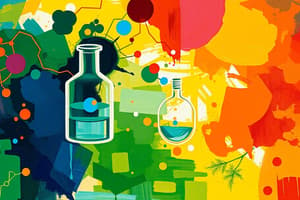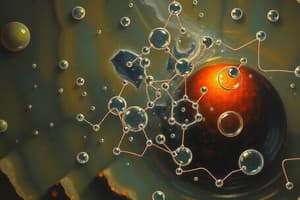Podcast
Questions and Answers
Which of the following elements constitutes the majority of body weight?
Which of the following elements constitutes the majority of body weight?
- Sodium
- Sulfur
- Chlorine
- Carbon (correct)
How many of the naturally occurring elements have a biological role?
How many of the naturally occurring elements have a biological role?
- 24 (correct)
- 92
- 6
- 12
Which of the following is NOT classified as a major element in living organisms?
Which of the following is NOT classified as a major element in living organisms?
- Nitrogen
- Oxygen
- Calcium
- Iron (correct)
What percentage of the body's weight is constituted by minerals?
What percentage of the body's weight is constituted by minerals?
Which of the following functions is associated with electrolytes?
Which of the following functions is associated with electrolytes?
What does the atomic number of an element represent?
What does the atomic number of an element represent?
What is the primary reason elements are organized by atomic number in the periodic table?
What is the primary reason elements are organized by atomic number in the periodic table?
How is the atomic mass of an element determined?
How is the atomic mass of an element determined?
What characterizes a nonpolar covalent bond?
What characterizes a nonpolar covalent bond?
What happens in a polar covalent bond?
What happens in a polar covalent bond?
What characterizes isotopes of an element?
What characterizes isotopes of an element?
What is the nature of a hydrogen bond?
What is the nature of a hydrogen bond?
What can radioactive isotopes potentially cause when they decay?
What can radioactive isotopes potentially cause when they decay?
Which of the following isotopes is radioactive?
Which of the following isotopes is radioactive?
Why are hydrogen bonds significant in physiology?
Why are hydrogen bonds significant in physiology?
Which of the following statements is true about nonpolar covalent bonds?
Which of the following statements is true about nonpolar covalent bonds?
What type of radiation can radioactive isotopes emit?
What type of radiation can radioactive isotopes emit?
What is one medical application of radioactive isotopes?
What is one medical application of radioactive isotopes?
How do hydrogen bonds affect water molecules?
How do hydrogen bonds affect water molecules?
What is true about the stable isotopes of an element?
What is true about the stable isotopes of an element?
Which of the following is NOT a characteristic of a polar covalent bond?
Which of the following is NOT a characteristic of a polar covalent bond?
What role do hydrogen bonds play in the structure of DNA?
What role do hydrogen bonds play in the structure of DNA?
Which of the following describes ionizing radiation?
Which of the following describes ionizing radiation?
What role does water play in chemical reactions?
What role does water play in chemical reactions?
How does water's high specific heat benefit the human body?
How does water's high specific heat benefit the human body?
What does a pH of 4.0 indicate about a solution's acidity?
What does a pH of 4.0 indicate about a solution's acidity?
What is true about the pH scale?
What is true about the pH scale?
What happens to water molecules in terms of temperature stability?
What happens to water molecules in terms of temperature stability?
What is the primary function of buffers in the body?
What is the primary function of buffers in the body?
Which compound acts as a weak base in the carbonic acid-bicarbonate buffer system?
Which compound acts as a weak base in the carbonic acid-bicarbonate buffer system?
What type of reaction is characterized by the formation of a more complex chemical structure?
What type of reaction is characterized by the formation of a more complex chemical structure?
Which process involves breaking complex substances into simpler components?
Which process involves breaking complex substances into simpler components?
Which of the following correctly represents a decomposition reaction?
Which of the following correctly represents a decomposition reaction?
In reversible reactions, which factor determines the direction of the reaction?
In reversible reactions, which factor determines the direction of the reaction?
What happens during dehydration reactions?
What happens during dehydration reactions?
What characterizes an exchange reaction?
What characterizes an exchange reaction?
How do buffers help maintain homeostasis?
How do buffers help maintain homeostasis?
What is a defining characteristic of metabolism?
What is a defining characteristic of metabolism?
Flashcards are hidden until you start studying
Study Notes
Atoms and Elements
- Elements are pure substances that cannot be decomposed into simpler forms; they represent the smallest amount of matter.
- The periodic table lists 92 naturally occurring elements; 24 of these have biological roles.
- Six elements account for 98.5% of body weight: oxygen, carbon, hydrogen, nitrogen, calcium, and phosphorus.
- Oxygen, carbon, hydrogen, and nitrogen alone represent 96% of body weight; remaining 4% includes trace elements.
Major Elements in Living Organisms
- Minerals are inorganic elements sourced from soil, essential for life, including calcium, phosphorus, chlorine, magnesium, potassium, sodium, and sulfur, making up about 4% of body weight.
- Minerals play crucial roles in body structure, enzyme functions, and are vital electrolytes for nerve and muscle activities.
Atomic Number and Mass
- Atomic number indicates the number of protons in an element and determines its position in the periodic table.
- Atomic mass is the sum of protons and neutrons in an atom.
- Isotopes of an element differ in neutron count but have the same number of protons and electrons, reacting chemically in the same way.
Radioactive Isotopes
- Unstable isotopes can undergo decay, releasing energy and atomic fragments, posing risks such as genetic mutations and cancer.
- However, radioactive isotopes have medical applications like imaging (MRI, CT scans) and targeted radiation therapy for tumors.
Covalent Bonds
- Covalent bonds can be nonpolar (equal electron sharing) or polar (unequal electron sharing).
- Nonpolar bonds are the strongest and involve equal time spent by electrons around nuclei, while polar covalent bonds create slight charges in molecules.
Hydrogen Bonds
- Hydrogen bonds are weak attractions between a slightly positive hydrogen atom and a slightly negative atom (oxygen or nitrogen).
- Essential in maintaining the structure of proteins and DNA, they influence the properties of water.
Chemical Reactivity
- Water's ability to ionize and participate in hydrolysis and dehydration synthesis is crucial for chemical reactivity.
- Functions as a solvent for acids and salts, essential in biological processes.
Thermal Stability of Water
- Water has a high specific heat, allowing it to absorb and release substantial heat with little temperature change, facilitating temperature regulation in living organisms.
Acids, Bases, and pH
- The pH scale quantifies hydrogen ion concentration; 7.0 is neutral, values below indicate acidity, and above indicate basicity.
- Each unit change in pH reflects a tenfold change in hydrogen ion concentration.
Buffers
- Buffers are compounds that help maintain pH homeostasis in body fluids, crucial for physiological functions.
- For example, blood pH is tightly regulated between 7.35 and 7.45 to prevent severe health issues.
Acid-Base Balance
- The carbonic acid-bicarbonate buffer system stabilizes blood pH by balancing H⁺ and OH⁻ ion concentrations.
- If pH falls, bicarbonate ions neutralize excess H⁺ to restore balance.
Chemical Reactions
- Chemical reactions involve the formation or breaking of bonds, categorized as reactants and products.
- Types include synthesis (combination), decomposition (breaking down), exchange (swapping components), and reversible reactions.
Metabolism
- Metabolism encompasses all chemical processes in the body, with catabolism (breaking down molecules) and anabolism (building complex molecules) being critical functions.
Types of Chemical Reactions
- Synthesis reactions combine small molecules into larger ones, while decomposition reactions split larger molecules into smaller parts.
- Exchange reactions exchange atoms or groups between molecules, reversible reactions can shift depending on reactant or product quantities.
Dehydration and Hydrolysis Reactions
- Dehydration reactions remove water to form bonds, while hydrolysis reactions add water to break bonds, integral for metabolic processes.
Upcoming Topics
- Future discussion will cover organic compounds, macromolecules, and biomolecules relevant to biological systems.
Studying That Suits You
Use AI to generate personalized quizzes and flashcards to suit your learning preferences.




